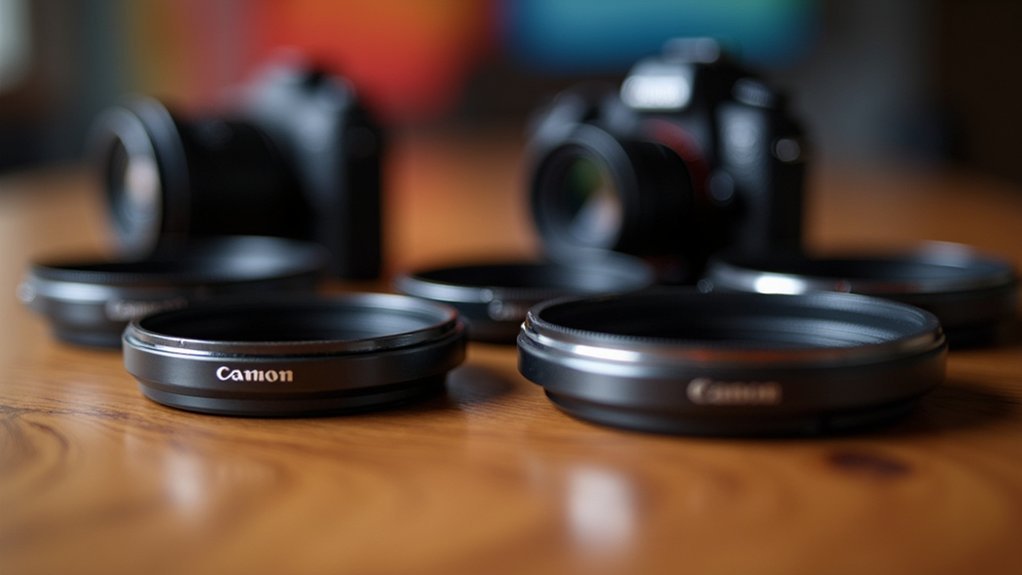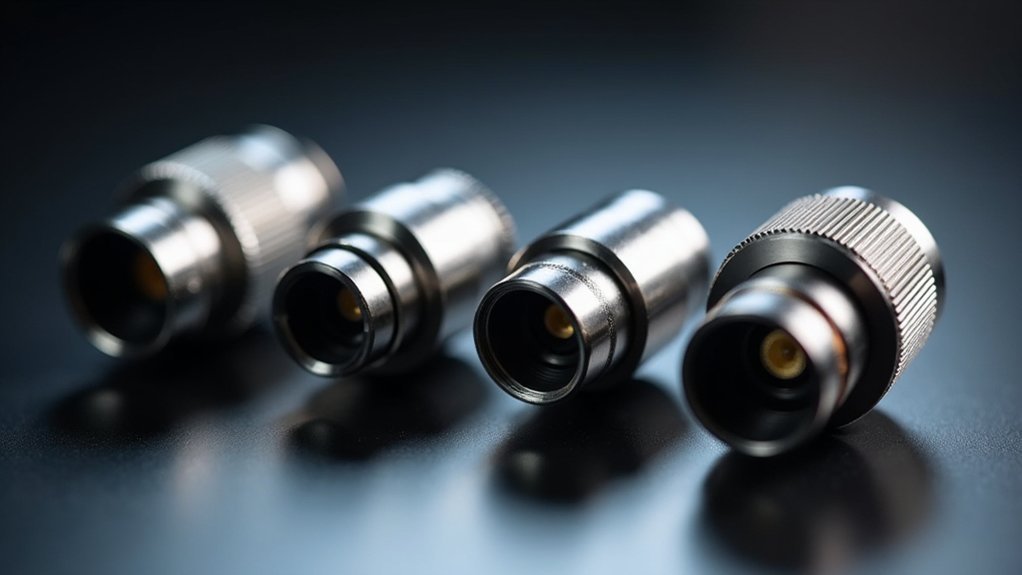Canon’s first-party lens adapters lead the market with excellent compatibility and performance for EOS R series cameras. For budget-conscious photographers, VILTROX and Commlite offer competitive auto-focus capabilities at lower prices. When choosing between $50-300 options, consider your specific camera system and lens collection. Premium adapters deliver better electronic integration, while third-party alternatives provide significant value. Explore the full comparison to discover which adapter will maximize your existing glass investment.
Canon Lens Adapters: Compatibility and Performance Review

When upgrading to Canon’s mirrorless EOS R series, what happens to your existing EF and EF-S lenses? You don’t need to replace them—the Canon Mount Adapter EF-EOS R bridges this gap perfectly. Rated at 9.4, this adapter guarantees seamless compatibility with the EOS RP, R6, and R5 cameras.
The standard Canon EF-EOS R Mount Adapter (9.1) offers similar performance at a comparable price point. Both first-party adapters maintain accurate infinity focus and provide smooth, secure fitting—crucial when changing lenses frequently during shoots.
While third-party lens adapters exist, investing in Canon’s official offerings prevents potential fit and functionality issues.
You’ll appreciate how these adapters maintain image quality and reliable performance, letting you expand your creative possibilities without sacrificing the investment you’ve already made in quality glass.
Third-Party Adapter Options for Mirrorless Systems
You’ll find third-party adapters offering excellent value compared to manufacturer options, with standouts like VILTROX and Commlite providing auto-focus capabilities at competitive prices.
Cross-brand compatibility has expanded considerably, allowing photographers to use legacy glass from Canon, Minolta, and other systems on modern mirrorless bodies from Fujifilm, Sony, and Canon.
When comparing auto-focus performance, budget-friendly options from EBYPHAN and VILTROX now rival OEM adapters, though specific lens compatibility varies between manufacturers.
Third-Party Budget Picks
Three standout budget adapters have emerged as excellent alternatives to first-party options for photographers shifting to mirrorless systems.
If you’re budget-conscious but need reliable auto-focus functionality for your Canon lenses on mirrorless cameras, these third-party options deliver impressive performance.
- EBYPHAN’s EF-EOS M Lens Adapter (score: 8.7) provides auto-focus capability for Canon EF/EF-S lenses on EOS-M cameras, balancing functionality with affordability.
- VILTROX EF-EOS M Mount Adapter (score: 8.6) supports electronic auto-focus and works with various EOS M models for versatile shooting experiences.
- Commlite’s CM-EF-EOS R Adapter (score: 8.5) enables seamless functionality for Canon EF/EF-S lenses on EOS R series cameras.
Users consistently praise these affordable alternatives for their reliable performance and ease of use, making your shift to mirrorless systems more economical without sacrificing essential features.
Cross-Brand Compatibility Chart
Numerous third-party adapters now bridge the gap between different lens mounts and camera systems, creating unprecedented flexibility for photographers invested in multiple brands.
You’ll find solutions like EBYPHAN and VILTROX adapters that connect Canon EF/EF-S lenses to EOS-M bodies, while Commlite’s CM-EF-EOS R adapter brings the same compatibility to EOS R cameras with full electronic auto-focus functionality.
For vintage glass enthusiasts, Fotasy offers adapters pairing Minolta MD lenses with Fuji X bodies, and Canon FD lenses with Sony’s E Mount cameras.
When selecting third-party adapters, consider premium options from Novoflex, which consistently ranks highest for precision and durability, or more budget-friendly alternatives from K&F Concept.
This cross-compatibility dramatically expands your creative options without requiring investment in entirely new lens collections.
Auto-Focus Performance Comparison
Modern third-party lens adapters have considerably narrowed the performance gap with first-party options, particularly in auto-focus capabilities.
When comparing third-party adapters for Canon mirrorless systems, you’ll find impressive performance across several brands.
- EBYPHAN EF-EOS M adapter (8.7 rating) delivers reliable auto-focus performance with Canon EF/EF-S lenses on EOS-M cameras, maximizing your existing lens collection.
- VILTROX EF-EOS M adapter (8.6 rating) offers comparable electronic auto-focus capabilities across various EOS M models while maintaining excellent affordability.
- Commlite CM-EF-EOS R adapter (8.5 rating) provides seamless integration with EOS R series cameras, extending your lens options without sacrificing functionality.
Users consistently praise these third-party adapters for delivering impressive auto-focus performance while offering significant cost savings compared to Canon’s first-party options.
This makes them attractive solutions for photographers expanding into mirrorless systems.
Budget-Friendly Microscope Camera Adapters Under $100
While exploring the world of microscopy can be expensive, you don’t need to spend a fortune on camera equipment to document your discoveries. Budget-friendly microscope camera adapters under $100 offer an excellent compromise between quality and affordability.
Microscopy exploration doesn’t require expensive equipment—affordable adapters under $100 provide quality documentation without breaking your budget.
Brands like K&F Concept and Fotodiox stand out in this category, providing reliable performance without breaking the bank.
You’ll find that most budget adapters feature universal compatibility with various microscope models, making them ideal for hobbyists and educators.
Whether you’re using DSLR or mirrorless cameras, there’s likely an affordable adapter that fits your setup.
Premium Microscope Photography Solutions for Professionals

For researchers, medical professionals, and industry specialists, stepping up from budget options opens a world of precision imaging capabilities.
Premium microscope photography solutions from industry leaders like Olympus and Nikon offer exceptional quality through specialized adapters designed for their microscope models.
When investing in professional-grade equipment ($200-$1,000+), you’ll benefit from:
- High-quality lens adapters with adjustable optical elements that allow customized magnification for specific specimen types
- Seamless integration with various camera systems, ensuring ideal alignment and compatibility for capturing microscopic details
- Advanced features including electronic control of focus and aperture settings, providing greater automation and precision
These premium solutions represent a significant investment but deliver the image quality and flexibility demanded by professionals who rely on microscopic imaging for critical applications.
Cross-Brand Compatibility: Making Older Lenses Work With Modern Cameras
As digital camera technology rapidly evolves, photographers needn’t abandon their beloved vintage glass. Cross-brand lens adapters enable compatibility between older lenses and modern mirrorless camera systems, preserving your investment while expanding creative options.
| Adapter Brand | Compatible With | Price Range |
|---|---|---|
| Novoflex | Canon EF to Sony | $150-$300 |
| K&F Concept | Nikon F to Fuji | $50-$120 |
| Metabones | M42 to Micro 4/3 | $100-$250 |
| Fotodiox | Minolta to Canon | $30-$90 |
High-quality adapters maintain precise focus and aperture control without compromising image quality. Many feature electronic auto-focus capabilities, seamlessly integrating vintage lenses with today’s technology. When choosing adapters, invest in quality options to avoid light leaks or mount damage while preserving the unique optical characteristics that make older lenses special.
Microscope-to-DSLR Adapters: Technical Specifications Comparison

The revolution in microscope photography has made capturing microscopic specimens more accessible than ever with specialized DSLR adapters.
When comparing microscope-to-DSLR adapters, you’ll find significant variations in technical specifications that impact your imaging quality and workflow.
- Most adapters utilize T-mount or C-mount threading systems, offering compatibility with various DSLR cameras while maintaining precise optical alignment.
- Adjustable tube lengths provide flexibility for different microscope setups, with premium models featuring fine-tuning capabilities for perfect focus.
- Price ranges typically span $50-300, with higher-end options offering brand-specific designs for Nikon and Canon DSLRs, superior materials, and built-in optics.
Choose an adapter that matches both your microscope model and camera brand for best results and seamless integration.
Frequently Asked Questions
What Brand Do Most Photographers Use?
You’ll find most photographers prefer first-party adapters from brands like Canon, Sony, and Fujifilm. Among third-party options, Novoflex leads with 28.3% market share, followed by K&F Concept at 18.3% and Metabones at 8.3%.
What Are the Top 5 Camera Brands?
The top 5 camera brands you’ll find most photographers using are Canon, Sony, Nikon, Fujifilm, and Panasonic. Each offers unique strengths in image quality, lens selection, and technological innovation for different photography needs.
Do Lens Adapters Affect Quality?
Yes, lens adapters can affect quality. You’ll notice better results with premium brands like Novoflex and K&F Concept that maintain proper alignment and prevent light leaks, reflections, and focus issues.
What Are the Best Camera Accessories?
You’ll need essential accessories like tripods for stability, SanDisk Extreme PRO memory cards for fast transfers, and cleaning tools like the NiSi Clever Cleaner. Quality lens adapters from Canon or Novoflex are also worthwhile investments.
In Summary
When choosing photo adapters in 2025, you’ll find options for every need and budget. Whether you’re connecting vintage lenses to mirrorless bodies, setting up microscope photography, or bridging between camera systems, today’s adapters offer remarkable compatibility and performance. Don’t hesitate to invest in quality adapters—they’ll protect your expensive optics while revealing creative possibilities you wouldn’t otherwise have with your current equipment.





Leave a Reply